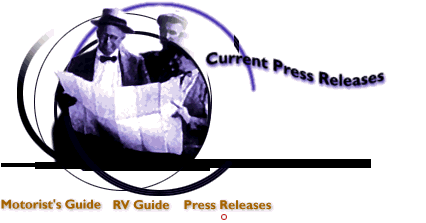|
|


Make regular tire care one of your New Year's resolutions! Find out how much you know about tire care by taking the test below:
- Your brakes stop the wheels, but the tires stop the car.
(True or False)
- Tire pressure should be lowered in the winter.
(True or False)
- In the tire size "P195/70R14", the number 14 means it is a radial tire.
(True or False)
- A tire with too little air pressure will wear more on the outside of the tread.
(True or False)
- Tires are not considered safe when the tread is less than 1/16' thick.
(True or False)
- Overloading a car has the same effect as having underinflated tires.
(True or False)
- Every time a tire screeches, the potential mileage is reduced.
(True or False)
- The best time to check the pressure in your tires is after a long trip.
(True or False)
- Worn tires are more likely to "hydroplane."
(True or False)
- While driving, if you think you have a flat tire, pull off the road immediately.
(True or False)
Answers:
- True. This is why tire care is so important. The control of your car is only as good as the tires' contact with the road.
- False. Tire pressure usually lowers itself in winter -- dropping about one pound for every 10 degrees the temperature falls. Check tires regularly, particularly during the winter months to ensure that the proper pressure is maintained.
- False. The letter "R" in the label "HR" means the tire is a radial. The number "14" indicates the rim diameter is 14.
- True. Too little air will cause excessive wear on the outside of the tread. Too much air pressure will cause undue wear on the middle of the tread.
- True. Many states have minimum tread depth laws that reject tires with tread worn below 1/16 of an inch in two or more adjacent grooves. The tire is considered worn out.
- True. Most people know that driving with underinflated tires causes excess tread wear as well as making the tire prone to failure. But most people don't realize that overloading their car's tires has exactly the same effect.
- True. The driver who feels it is necessary to "peel out" from a stop sign or squeal around a corner potentially has erased hundreds of miles from the tread life of the tire.
- False. Tire pressure will increase while driving so it is important to check tire pressure when tires are "cold" -- in the morning or BEFORE starting a trip. Recommended tire pressure is always expressed as "cold tire pressure."
- True. A tire's tread grooves are designed to evacuate water from under the tread. If tires are worn, they are more likely to "hydroplane." This means they surf along on a film of water just like a water skier.
- False. It is important to come to a gradual stop if you believe you have a flat tire. The driver should not pull off the road until he finds a safe place. It's better to ruin a tire than risk an accident.
The Council offers a free brochure on tire care for cars and light trucks. To order the guide, send a self-addressed, stamped business-size envelope to: Tire Industry Safety Council, P.O. Box 3147, Medina, OH 44258. The Council also offers a tire care kit which includes an air pressure gauge, a tread depth measurer, four valve caps and a tire care brochure. To order a kit, send a check or money order for $4.00 to the above address.

| Current Press Releases |
|

